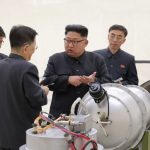
New fears of World War III as North Korea tests ICBM that can “hit anywhere in the world” — regime will field nukes by next year
Tuesday, November 28, 2017 by JD Heyes
http://www.preparedness.news/2017-11-28-new-fears-of-world-war-iii-as-north-korea-tests-icbm-that-can-hit-anywhere-in-the-world.html

President Donald J. Trump campaigned on a pledge to never allow North Korea to develop nuclear weapons or the capability to threaten the U.S. with them.
But after Tuesday Pyongyang appears on the verge of doing both following the successful test of an ICBM that flew longer and farther than previous ballistic missiles the North has launched over the past year.
In short, North Korea is forcing Trump’s hand, especially after analysts at the Defense Intelligence Agency estimate that Pyongyang will field a nuclear-capable ICBM sometime next year.
As reported by CNN, Trump told reporters at the White House shortly after Pyongyang launched its missile that the United States “will handle” the situation in no uncertain terms.
“We will take care of it,” Trump promised, later adding that North Korea “is a situation that we will handle.”
Without question, Trump now has no choice.
Seated with the president during a meeting with House Speaker Paul Ryan, R-Wis., and Senate Majority Leader Mitch McConnell, R-Ky., Secretary of Defense James Mattis told reporters that the missile involved in the latest test traveled “higher, frankly, than any previous shot they have taken.”
Later, Mattis — who has said North Korea cannot hope to defeat the United States — told reporters that Pyongyang now has developed the capability to send a missile “everywhere in the world, basically,” obviously putting the U.S. in range — and in danger.
At the Pentagon, spokesman U.S. Army Col. Rob Manning III told reporters the North Korean ICBM was “launched from Sain Ni, North Korea, and traveled about 1,000 kilometers before splashing down in the Sea of Japan, within Japan’s Economic Exclusion Zone.”
He added that the U.S. tracked the missile after it was launched.
“The North American Aerospace Defense Command (NORAD) determined the missile launch from North Korea did not pose a threat to North America, our territories or our allies,” Manning added.
The launch came just days after Japanese intelligence determined that a launch was imminent. As reported by Forward Observer, earlier this week Japan said its intelligence service believed a launch could come “in the next few days,” in a forecast that proved to be spot-on. (Related: Pentagon says a ground invasion of North Korea only way to secure nuclear weapons.)
One official in Tokyo said that the Japanese had intercepted radio signals from North Korea indicating that a launch was imminent.
Shortly after Pyongyang’s launch, the South Korean military launched a missile of its own, demonstrating at “precision strike” capability that Seoul could target North Korean launchers and the country’s leadership with ease.
“South Korea apparently used this launch to prove it has the ability to hit the North’s mobile missile launchers or leadership targets,” Adam Mount, a North Korea expert and senior fellow at the Center for American Progress, told CNN.
“It is a measured and pointed response but also a reminder that the peninsula remains on hair trigger alert,” he added. “In this situation, provocations or even mistakes could quickly escalate out of control.”
In recent days the Russian government has praised the North’s restraint, noting that Pyongyang had not launched any missiles in two months. But Russian diplomats have also warned that the situation on the Korean peninsula could turn apocalyptic as well, and very quickly.
“I hope that a common sense, pragmatism and an instinct of self-preservation would prevail among our partners to exclude such negative scenario,” Russian Deputy Foreign Minister Igor Morgulov said at an annual conference in South Korea.
It may come to that. Mound says that it’s become obvious that Pyongyang is more interested in developing what it believes will secure the regime of Kim Jong-un — a nuclear deterrence — than avoiding a possible retaliatory strike.
“Today’s test proves that Pyongyang still feels able to test at will,” he told CNN, adding that it also indicates to the Trump administration that it “has to get serious about deterring an atmospheric nuclear test.”
He also noted that the 50-minute flight time suggests that this was a major ICBM test “possibly in operational settings.” He said it should “disabuse U.S. officials from thinking military displays, sanctions, or threats are deterring North Korean tests.”
J.D. Heyes is a senior writer for NaturalNews.com and NewsTarget.com, as well as editor of The National Sentinel.
Sources include:
Tagged Under: Tags: ICBM, James Mattis, North Korea, nuclear war, nuclear weapons, Pentagon, prepper, President Trump, United States, World War III





